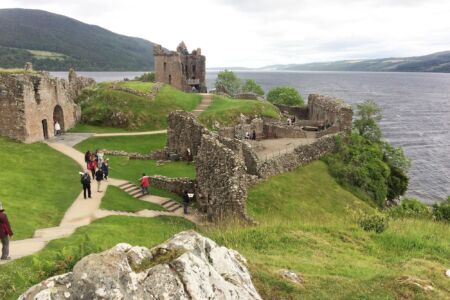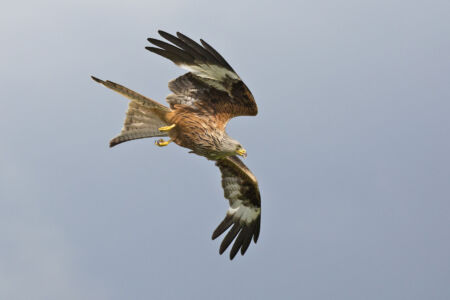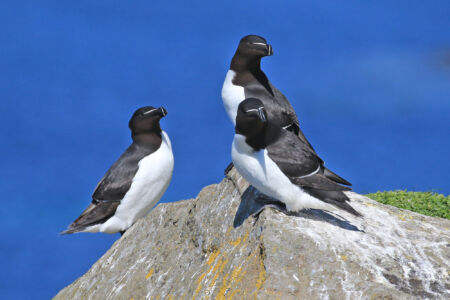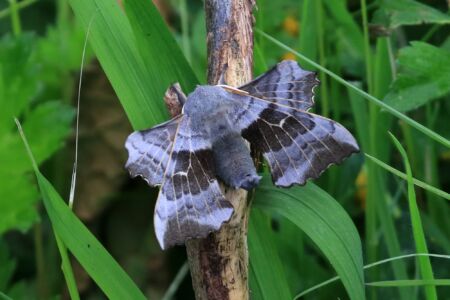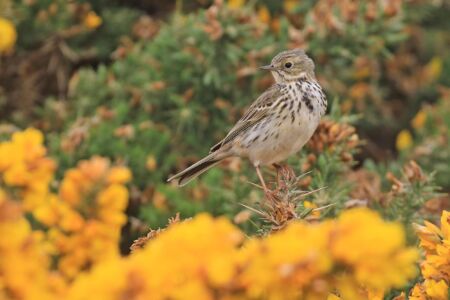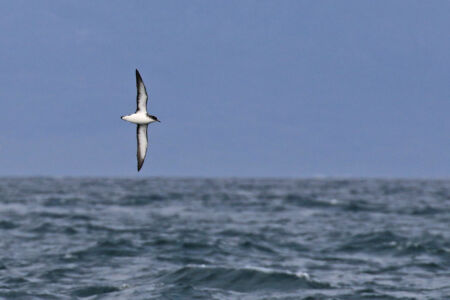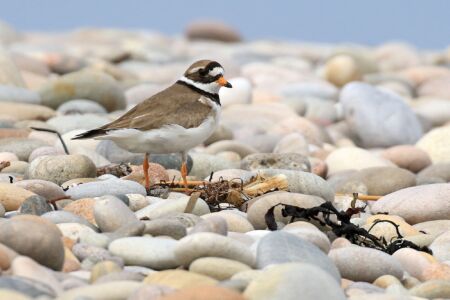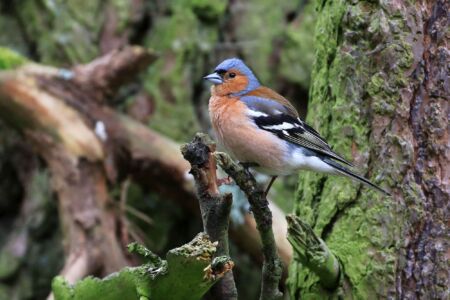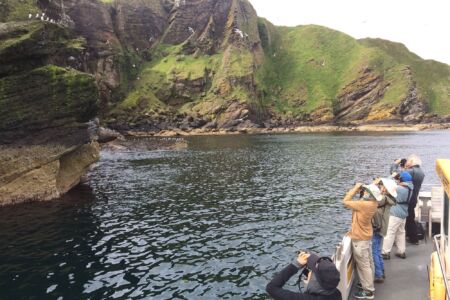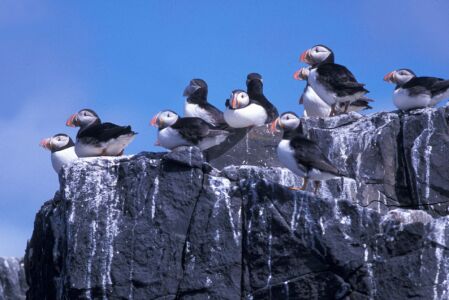SCOTLAND: Highlands & Orkney

TOUR FOCUS
BIRDS & WILDLIFE
SCHEDULED TOURS
TRIP LEADERS
TOUR COST
From: $8,500 (See details)
Cost is per person, double occupancy from Inverness, Scotland (INV)
GROUP SIZE
6 Participants
AVAILABILITY
2024 trip is FULL. Next Scotland trip………
taking registrations for May 30-June 14, 2026 Highlands & Outer Hebrides; cost tbd
PRIVATE TOUR OPTION
This tour is available as a private trip for any size group. The tour cost will vary with the number of people and any custom requests.
TESTIMONIALS
Highlights of SCOTLAND: Highlands & Orkney
Description of SCOTLAND: Highlands & Orkney
Length of Tour
15-days/14-nights
Brief Itinerary
Day 1 – AM arrival at Inverness; PM transfer to Nethy Bridge
Day 2 – Abernethy Forest and lochs
Day 3 – Moorlands and Black Isle
Day 4 – Cairngorm Plateau
Day 5 – Troup Head and East coast
Day 6 – Moray Coast and Black Isle
Day 7 – Loch Ness, Urquhart Castle and distillery
Day 8 – Transfer to Orkney
Day 9 – West Mainland
Day 10 – Westray
Day 11 – Hoy
Day 12 – Rousay and West Mainland
Day 13 – Mainland
Day 14 – Transfer to Highlands
Day 15 – AM departure from Inverness
Itinerary
Day 1 : AM arrival in Inverness; PM transfer to Nethy Bridge
AM arrival (by noon) at Inverness Airport (INV) and transfer to Mountview Hotel, Nethy Bridge, our base in the Highlands for the next seven nights.
Days 2 – 7 : The Scottish Highlands
Today we head north to visit the spectacular ruins of Urquhart Castle on a peninsula surrounded by Loch Ness. In its 500 years of being a medieval castle, Urquhart has played several important roles and been a popular recurring feature in and of Scottish history. In particular, the castle faced a considerable amount of action and bloodshed during the 13th to 17th centuries. It was seized by the English after Edward I’s invasion, reclaimed and seized again, was under the control of Robert the Bruce, King of Scots in the 14th century and was repeatedly attacked during the 15th and 16th centuries by the MacDonald Lords of the Isles arriving from the West; to recap the very least from its thrilling history. The visitor centre is excellent, and includes a sizeable model of the castle, depicting what it might have looked like in its prime. The exhibition also consists of a theatre which runs an informative movie about the history of the castle from the 6th century to the 17th century.
We round the day off with a visit to a local Malt Whisky Distillery where we can sample some of the malts Speyside has to offer!
Cost
$8,500 per person, based upon double occupancy, from Inverness, Scotland (Airport code INV).
This trip ends in same as arrival city (Airport code ).
Single Supplement and other Cost Additions
If a single room is preferred, or we are unable to find a suitable roommate for you, a single supplement fee of $750 will be assessed.
Cost includes
14 nights en-suite accommodation; all meals from dinner on Day 1 to breakfast on Day 15 (unless you are on an early flight); all transportation by comfortable minibus from Inverness; guidance from professional leader(s); all entrance, ferry and boat fees.
Cost does not include
Travel to Inverness [INV] meeting point; travel insurance; tip to hotel staff and local leader; drinks and other items of a personal nature.
Minimum Number
If fewer than the minimum number of participants are registered the trip can still run with a small-group supplement fee per person determined by the number of participants.
Deposit Requirements
A $500 deposit per person is required to hold each space on this tour. Deposit may be made online by clicking the "Book Your Trip Now" button and using any credit card. If you prefer, you may call us at 888-875-9453 to pay by phone. You may also mail us a check, however, remember that all space is held on a first come-first served basis as deposits are received.
How to Book
In order to hold your space, click the "Book Your Trip Now" button above and complete the deposit process, including payment of the deposit through our Paypal portal using ANY CREDIT CARD. Upon completion of deposit, please visit our secure, online CLIENT INFORMATION FORM to complete your registration.
Final Payment
For all land-based tours: full payment by check is due 120 days prior to the departure date.
For all boat-based adventure cruises of 7-days or longer: full payment by check is required 180 days prior to departure.
NOTE: If you prefer to use credit card for final payment, a 3% fee may be added to cover the credit card merchant fees we incur.
14 nights at two centers, all ensuite, in comfortable hotels.
In the Highlands we will be based for 7 nights in Nethy Bridge at the Mountview Hotel.
We are at 1 location on Orkney, in Kirkwall, for 6 nights..
Our last (14th) night we will near Inverness Airport
Activity Level Rating: 4 (Note: 1 is easy and 5 is difficult)
Walking:
You need a reasonable level of fitness.
There will be short to moderate (3- 8 mile) walks every day, at a slow pace. The terrain is mostly level, though there will be times when we walk distances in soft sand, through moist meadows and moorlands, over stoney ground, up steps, and over rough, uneven or soft ground with several stiles to climb over. Walks on Rousay are on relatively steep grassy paths, and there is a strenuous mountain walk in the Highlands to the Cairngorm Plateau, of 6+ miles return walk climbing up 2000 feet to 4000 feet. On the island of Hoy there is a 5-6 mile return walk with an altitudinal climb of about 300 ft to view the Old Man of Hoy.
Recommended Field Guide:
Birds of Europe
(3rd Edition, 2022, Princeton University Press)
by Lars Svensson, Killian Mullarney and Dan Zetterstrom
This trip is for non-smokers only. Smoking is not permitted at any time during our tour.
No Visa is required to visit the United Kingdom.
Weather:
Expect a wide variation in weather conditions. Blazing sunshine and rain are equally likely, and you will probably experience a bit of everything. Average June temperature 48-60F. Bring waterproofs, walking boots or shoes (we will walk through wet grass and puddles of water) and warm clothing. Strong winds can be a feature on the islands.
The month of June has about 19 hours of daylight.
Walking:
You need a reasonable level of fitness.
Walking on the Cairngorms Plateau for Ptarmigan and Dotterel is strenuous, requiring a longer walk as we climb about 2000 ft in elevation, from about 2000 ft to 4000 ft.
Ferry and Boat rides:
Several ferry rides are needed to access the islands in Orkney. We also have a boat trip to view the gannetry at Troup Head.
Transportation:
All transportation will be by comfortable minibus
Purchasing Flights
Do not purchase your flights until the trip has been confirmed to go.
Detailed Trip Information
Upon notification that final payment is due (120 days prior to departure for land based tours / 180 days for boat based tours), you will receive a trip package of detailed information for your tour.
Any additional information about the trip, including lodgings, contacts, participants, meeting locations, etc., will sent about 2 weeks prior to the trip departure, or after final payment is received for late registrants.
Travel Insurance
As with all tours, we recommend purchasing Travel Insurance to help cover your investment, for covered reasons. Please see our section on Travel Insurance.
Passport & Visa
US Citizens may require a visa to enter certain foreign countries. See above for any required visa information.
Participants arriving to the USA from a foreign country may need to get a travel visa to enter the United States. Be sure to check the requirements for your country of origin.
Itinerary Changes
The trip itinerary is developed many months ahead of time. Occasionally, despite our best planning, changes may occur during the trip, or we may be forced to alter our plans. Changes may occur because of weather, road conditions, safety concerns or other circumstances. In these situations, it is the leader(s) responsibility to carefully consider and implement appropriate alternatives. Any additional costs incurred because of changes will be the responsibility of each individual participant. Refunds will not be issued as a result of itinerary changes.
2018 Trip Report SCOTLAND Highlands & Inner Hebrides
2018 Species Recorded SCOTLAND
2017 Trip Report SCOTLAND Highlands & Inner Hebrides
2017 Species Recorded SCOTLAND
2016 Trip Report SCOTLAND Highlands & Inner Hebrides
2005 Trip Report SCOTLAND Highlands & Shetland


